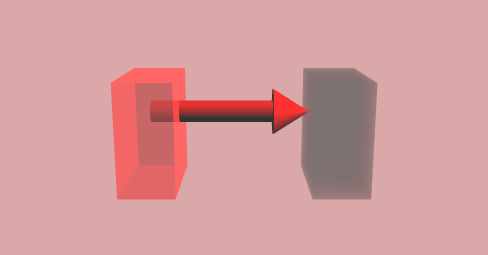
Figure 1. The Force Arrow.
The Axial System of Transitive Force. The relative locations of objects in the Cognitive Image are governed by the direction of the transitive force that links them. This direction is indicated by the Force Arrow in the Cognitive Image (Fig. 1). Direction is encoded in suffixes on the verbal stem or in the verbal stem itself. The Force Arrow lies along one of two axes: the Forward Axis or the Lateral Axis.

The Forward Axis originates at the speaker's viewpoint and runs forward in the Cognitive Image. The speaker's perspective on the flow of force may be prospective, in which energy flow is directed away from the speaker's viewpoint, or it may be retrospective, with energy flow directed toward the speaker's viewpoint (Fig. 2). Because energy flows in the direction of time, retrospective perspective implies a viewpoint that looks backward into time, while prospective perspective implies a viewpoint that looks forward into time.1
The Force Arrow runs along the Forward Axis between the Foreground and the Background of the Cognitive Image. Objects at the end-points of the Force Arrow are accordingly foregrounded or backgrounded. The object in the Foreground, being closer to the speaker's viewpoint, is the Subject of the Image.

The Lateral Axis runs from left to right (by convention) in the Foreground of the Cognitive Image. Objects linked by the Force Arrow along this axis lie uniformly in the Foreground (Fig. 3).

Encoding of Axis in the Verb. Like most languages of the region, Aćharêtâʹ verbs have two stems: an Unmarked Stem and a Retrospective Stem, which derive from the ancient Indo-European Present Stem and the Past Passive Participle, respectively. The Retrospective Stem is marked by the suffixes -l-, -t-, or -n- to the Unmarked Stem; in some cases it suppletes it (e.g., Unmarked pâš- 'see', but Retrospective dhrîʹṣṭ- 'seen'). The choice of stem determines the axis of the Force Arrow:
Functional Roles of Objects. The functional role that an object plays in a Cognitive Image depends on its location on the Force Arrow. An object is the:
An additional functional role, not related to the Force Arrow, distinguishes the Location of an object, either uniquely in the world or in relation to another object.
Subject Reference in the Verb. Suffixes on a verb's stem link the verb's Force Arrow to the Subject, which lies in the Foreground. For Retrospective verbs subject-linking is to the foregrounded Patient, at the end-point of the force. For Non-Retrospective verbs subject-linking is to the Agent, at the source of the force. Suffixes indicate the Subject's
Ordering. In a basic transitive sentence the objects appear first in the Cognitive Image, followed by a change in the Image depicted by the verb. Because the direction of the Force Arrow is specified by the verb after the objects have been placed into the Image, there must be some way to tell which object is the Agent and which is the Patient at the time of their appearance. The basic, iconic way places the objects in the order of the Force Arrow: Agent first, then Patient. This way is used regardless of the Force Arrow's direction.
Backgrounding. The backgrounding of an Agent is determined when a Retrospective Verb Stem appears. Redundantly, certain objects may indicate their backgrounding when their nominal forms appear, before the appearance of the verb. Accordingly, objects fall into two major classes according to whether their nouns show backgrounding or not when they occur as the Agents of Retrospective verbs.
Objects of the Non-Backgrounding Class show no indication of functional role in the forms
of their nouns. This class includes the ever-increasing share of loanwords in the language. For such
objects the backgrounding of Retrospective Agents is not indicated until the Retrospective verb appears,
as in (hypothetical)
 phʹay 'girl' |
 ghʹûṛi 'mare' |
 dhrîʹṣṭi 'seen[RETRO]-FEM' |
Anticipating the indication encoded in a Retrospective verb, an object of the Backgrounding Class shows its role as Retrospective Agent as soon as it appears, through a suffix to its noun (the so-called "ergative" suffix), as in (hypothetical)
 phôʹ 'boy' |
 -a '-BACK' |
 ghʹûṛi 'mare' |
 dhrîʹṣṭi 'seen[RETRO]-FEM' |
The basic backgrounding suffixes are
In addition, the plural suffix
Convergence of Backgrounded Singular and Foregrounded Plural. The identity of most backgrounded singular and foregrounded plural forms presents an ambiguity in the initial depiction of their objects, which is only resolved by the Axis encoded in the following verb.2 Thus as the following two hypothetical sentences unfold, it is not clear at first (absent other cues which would normally appear in context) whether ghêʹi is backgrounded singular 'cow' or foregrounded plural 'cows'. In either event, it is the Agent, because it comes first. The second word, gʹua, can only be foregrounded plural 'bulls' as the Patient, because the Agent has already been expressed, precluding an interpretation as backgrounded singular. Only when the verb appears is the ambiguity of ghêʹi resolved (Fig. 6):
 ghêʹi 'cow-PL' | 'cow-BACK' |
|
 gʹua 'bull-PL' |
|
 pašʹênim 'see-PROG-FEM-PL' |
 dhrîʹṣṭa 'seen[RETRO]-PL' |
Backgrounded Pronominal Patients. Because pronouns depict zonal distances along the Forward Axis, they lie on that axis in all their functions. When they occur with Non-Retrospective verb forms, pronominal Patients lie backgrounded on the Forward Axis, determining that the Force Arrow be Prospective rather than Lateral. Because a pronominal Patient is indicated in the same way whether the Force Arrow is Prospective or Retrospective, the Patient must lie in Mid-Background, between a Non-Retrospective Agent in the Foreground and a Retrospective Agent in the Far-Background (Fig. 7).
Pronouns that show two such degrees of backgrounding include the deictic, indefinite, and plural
personal pronouns, as given in the table below. The singular personal pronouns
show a single degree of backgrounding, like other Backgrounding-Class objects. From their form they
appear to have once followed a two-degree depiction similar to the other pronouns, but later lost their
ancient Foregrounded ("Nominative") forms.

Instrument. A noun's "instrumental" role is represented by its backgrounded plural form. A few nouns have a slightly different form; e.g., côriʹôm 'like thieves' vs. côrʹôm 'thieves' [Retrospective Agent].
Location. An object's Locational function depicts its unique location if it is a place name (e.g., aćharêtʹa 'in Aćharêʹt') or its location as a base for postpositions that locate other objects relative to it. The Locational function is indicated by the backgrounded form of a Backgrounding-Class object, or by the Mid-Backgrounded form of a pronoun.
A special "genitive-ablative" postposition (-î) indicates the source of another object (the "genitive" case) or the origin of motion if the object is inanimate (the "ablative" case); it appears after the unmarked singular or the plural "locative case" form. The postposition typically fuses with the unmarked singular form, replacing a final a (except for ʹa stem nouns of the -i Class; see below), y, i, or î and shortening a vowel in a preceding syllable. Among plural pronouns, the postposition contrasts paradigmatically with the "accusative/locative" case suffix (see the table below).
The pronouns mʹa 'I', aṛʹa 'yon', and ta- 'that' have a "basic locative" form ending in -ʹâ. mʹâ serves as the destination for the postposition thʹe 'to' (mʹâ-the 'to me'); aṛʹâ and tʹâ indicate deictic locations only ('there'). The corresponding locative form for the proximal deictic pronoun anʹu 'this one' falls outside this pattern: ʹinda 'here'.
Inflectional Classes of Nouns. A suffix fuses with its noun. In the resulting word the suffix may replace a final vowel of the noun stem or may engender an intervening glide between the final vowel and the suffix, and a preceding vowel may undergo shortening or lengthening, fronting, or lowering, depending of the position of accent (details appear in the section on phonology). Such morphophonemic changes are not necessarily automatic, but depend on the inflectional subclass to which the noun belongs.
Nouns fall into major inflectional classes based on their foregrounded plural suffixes. Major classes include
-i Class nouns are feminine, except for the subclass of ôʹ Stems (see the tables below). For those nouns (including inflecting adjectives and verbal participles) that show feminine gender in addition to their unmarked ("masculine") forms, inflection follows the patterns of the nonbackgrounded -i Class (see the tables below).
| Pronouns: Deictic, Indefinite, and Plural Personal | ||
|---|---|---|
| Singular | Plural | |
| "Basic Locative" | aṛʹâ | tʹâ | |
| far backgrounded ("Ergative") |
anʹî | aṛʹî | tʹî |
kʹî [CLOSE] | [DISTAL] | [CONCEPTUAL] | [INDEF.] |
aninʹim | aṛanʹim | tânim [CLOSE] | [DISTAL] | [CONCEPTUAL] asʹim | tusʹim [SPEAKER] | [HEARER] |
| mid backgrounded ("Accusative/Locative/ Ablative/Genitive") |
anʹis | aṛʹas | tʹas | kasʹe [CLOSE] | [DISTAL] | [CONCEPTUAL] | [INDEF.] |
"Accusative/Locative" aninâʹm | aṛanâʹm | tânâʹm [CLOSE] | [DISTAL] | [CONCEPTUAL] asâʹm | tusâʹm [SPEAKER] | [HEARER] |
| "Ablative/Genitive" aninʹî | aṛanʹî | tânʹî [CLOSE] | [DISTAL] | [CONCEPTUAL] asʹî | tusʹî [SPEAKER] | [HEARER] |
||
| foregrounded ("Nominative") |
anʹu, anʹi F. | aṛʹo, aṛʹe F. | sʹo, sʹe F. | kôʹ [CLOSE] | [DISTAL] | [CONCEPTUAL] | [INDEF.] |
anʹi | aṛʹe | sʹe [CLOSE] | [DISTAL] | [CONCEPTUAL] bʹe | tʹus [SPEAKER] | [HEARER] |
| Pronouns: Singular Personal | ||
|---|---|---|
| Singular | ||
| "Basic Locative" | mâ | | |
| backgrounded ("Ergative/Locative/ Genitive") |
mʹî | thʹî [SPEAKER] | [HEARER] |
|
| foregrounded ("Nominative/Accusative") |
mʹa | tʹu [SPEAKER] | [HEARER] |
|
| Nouns: Unaccented -a Class tʹôro 'star', kʹâṇ 'ear', bhʹit 'board' |
|||
|---|---|---|---|
| Singular | Plural | ||
| tʹôram, kʹâṇam, bhʹitam | backgrounded ("Ergative/Locative") |
||
| backgrounded ("Ergative/Locative") |
tʹôra, kʹâṇa, bhʹita | foregrounded ("Nominative/Accusative") |
|
| foregrounded ("Nominative/Accusative") |
tʹôro, kʹâṇ, bhʹit | ||
| Nouns: Unaccented -a Class î and û Stems (with Vowel Shortening) ac̣hʹî 'eye', gʹû 'bull' |
|||
|---|---|---|---|
| Singular | Plural | ||
| ac̣hʹiam, gʹuam | backgrounded ("Ergative/Locative") |
||
| backgrounded ("Ergative/Locative") |
ac̣hʹia, gʹua | foregrounded ("Nominative/Accusative") |
|
| foregrounded ("Nominative/Accusative") |
ac̣hʹî, gʹû | ||
| Nouns: Unaccented -a Class ʹô Stems (with Glide Insertion) nʹô 'name' |
|||
|---|---|---|---|
| Singular | Plural | ||
| nʹôwam | backgrounded ("Ergative/Locative") |
||
| backgrounded ("Ergative/Locative") |
nʹôwa | foregrounded ("Nominative/Accusative") |
|
| foregrounded ("Nominative/Accusative") |
nʹô | ||
| Nouns: Unaccented -a Class Irregular Stems kʹuṛi 'woman', šʹûr 'spouse's father', zʹir 'thousand' |
|||
|---|---|---|---|
| Singular | Plural | ||
| kuṛʹînam, šawʹuram, zʹaram | backgrounded ("Ergative/Locative") |
||
| backgrounded ("Ergative/Locative") |
kuṛʹîna, šawʹura, zʹara | foregrounded ("Nominative/Accusative") |
|
| foregrounded ("Nominative/Accusative") |
kʹuṛi, šʹûr, zʹir | ||
|
Nouns: Accented -a Class kâʹl 'year', mʹuṭ 'tree' |
|||
|---|---|---|---|
| Singular | Plural | ||
| kâlʹôm, muṭʹôm | backgrounded ("Ergative/Locative") |
||
| backgrounded ("Ergative/Locative") |
kâlʹa, muṭʹa | foregrounded ("Nominative/Accusative") |
|
| foregrounded ("Nominative/Accusative") |
kâʹl, mʹuṭ | ||
|
Nouns: Accented -a Class (with Vowel Shortening) hâʹl 'plow', bʹâṭ 'stone', dhîʹ 'daughter', ghôʹṣṭ 'house' |
|||
|---|---|---|---|
| Singular | Plural | ||
| halʹôm, baṭʹôm, dhiʹôm, ghoṣṭʹôm | backgrounded ("Ergative/Locative") |
||
| backgrounded ("Ergative/Locative") |
halʹa, baṭʹa, dhiʹa, ghoṣṭʹa | foregrounded ("Nominative/Accusative") |
|
| foregrounded ("Nominative/Accusative") |
hâʹl, bʹâṭ, dhîʹ, ghôʹṣṭ | ||
|
Nouns: Accented -a Class ôʹ Stems (with Glide Insertion) kôʹ 'olive' |
|||
|---|---|---|---|
| Singular | Plural | ||
| kôwʹôm | backgrounded ("Ergative/Locative") |
||
| backgrounded ("Ergative/Locative") |
kôwʹa | foregrounded ("Nominative/Accusative") |
|
| foregrounded ("Nominative/Accusative") |
kôʹ | ||
|
Nouns: Accented -a Class Irregular âʹ and ôʹ Stems (with Glide Insertion) mâmâʹ 'mother's brother', phôʹ 'boy' |
|||
|---|---|---|---|
| Singular | Plural | ||
| mâmayʹôm, phayʹôm | backgrounded ("Ergative/Locative") |
||
| backgrounded ("Ergative/Locative") |
mâmayʹa, phayʹa | foregrounded ("Nominative/Accusative") |
|
| foregrounded ("Nominative/Accusative") |
mâmâʹ, phôʹ | ||
|
Nouns: Accented -a Class Irregular i Stems kursʹi 'chair', wasirʹi 'yearling male goat' |
||
|---|---|---|
| Singular | Plural | |
| backgrounded ("Ergative/Locative") |
kursʹi, wasirʹi | kursiʹôm, wasirʹîm |
| foregrounded ("Nominative/Accusative") |
kursiʹa, wasiriʹa | |
|
Nouns: Plural -âʹn Class tarbʹûr 'agnate' |
||
|---|---|---|
| Singular | Plural | |
| backgrounded ("Ergative/Locative") |
tarbʹûra | tarbûrânôʹm * |
| foregrounded ("Nominative/Accusative") |
tarbʹûr | tarbûrâʹn |
* Also noted as tarburânôʹm.
| Nouns: Accented -i Class ǰêʹp 'pocket' |
|||
|---|---|---|---|
| Singular | Plural | ||
| ǰêpʹîm | backgrounded ("Ergative/Locative") |
||
| backgrounded ("Ergative/Locative") |
ǰêpʹi | foregrounded ("Nominative/Accusative") |
|
| foregrounded ("Nominative/Accusative") |
ǰêʹp | ||
| Nouns: Accented -i Class (with Vowel Shortening) âṣâʹṛ 'apricot' |
|||
|---|---|---|---|
| Singular | Plural | ||
| âṣaṛʹîm | backgrounded ("Ergative/Locative") |
||
| backgrounded ("Ergative/Locative") |
âṣaṛʹi | foregrounded ("Nominative/Accusative") |
|
| foregrounded ("Nominative/Accusative") |
âṣâʹṛ | ||
| Nouns: Accented -i Class (with Vowel Fronting) bâʹt 'word' |
|||
|---|---|---|---|
| Singular | Plural | ||
| bêtʹîm | backgrounded ("Ergative/Locative") |
||
| backgrounded ("Ergative/Locative") |
bêtʹi | foregrounded ("Nominative/Accusative") |
|
| foregrounded ("Nominative/Accusative") |
bâʹt | ||
| Nouns: Accented -i Class ôʹ Stems (with Vowel Fronting) haṇôʹ 'egg' |
|||
|---|---|---|---|
| Singular | Plural | ||
| haṇêʹm | backgrounded ("Ergative/Locative") |
||
| backgrounded ("Ergative/Locative") |
haṇêʹ | foregrounded ("Nominative/Accusative") |
|
| foregrounded ("Nominative/Accusative") |
haṇôʹ | ||
| Nouns: Accented -i Class Irregular ôʹ Stems (with Vowel Fronting) phâṭakôʹ 'male descendant of phâṭʹak' |
|||
|---|---|---|---|
| Singular | Plural | ||
| phâṭakêʹm or phâṭakʹum | backgrounded ("Ergative/Locative") |
||
| backgrounded ("Ergative/Locative") |
phâṭakêʹ | foregrounded ("Nominative/Accusative") |
|
| foregrounded ("Nominative/Accusative") |
phâṭakôʹ | ||
| Nouns: Accented -i Class ʹa Stems (with Vowel Fronting) c̣aṇJ̣ʹa 'torch' |
||
|---|---|---|
| Singular | Plural | |
| backgrounded ("Ergative/Locative") |
c̣aṇJ̣ʹa | c̣aṇJ̣êʹm |
| foregrounded ("Nominative/Accusative") |
c̣aṇJ̣êʹ | |
| Nouns: Accented -i Class âʹ Stems (with Vowel Shortening) xalâʹ 'fort' |
|||
|---|---|---|---|
| Singular | Plural | ||
| xalaʹim | backgrounded ("Ergative/Locative") |
||
| backgrounded ("Ergative/Locative") |
xalaʹi | foregrounded ("Nominative/Accusative") |
|
| foregrounded ("Nominative/Accusative") |
xalâʹ | ||
| Nouns: Accented -i Class Irregular Stems bhêʹṇ 'sister' |
||
|---|---|---|
| Singular | Plural | |
| backgrounded ("Ergative/Locative") |
bhêṇʹi | bhêṇʹîm |
| foregrounded ("Nominative/Accusative") |
bhêʹṇ | |
| Numbers: -u Class Numbers 'five' and above, except 'six', 'nine', 'twenty', 'hundred', and 'thousand' (with Vowel Shortening or Vowel Lowering) pʹânǰ 'five', bʹôš 'twelve', trʹîš 'thirteen' |
||
|---|---|---|
| Singular | Plural | |
| backgrounded ("Ergative/Locative") |
panǰʹum, bâšʹum, trêšʹum | |
| foregrounded ("Nominative/Accusative") |
pʹânǰ, bʹôš, trʹîš | |
| Nouns: Unaccented -i Class ghʹûṛi 'mare' |
||
|---|---|---|
| Singular | Plural | |
| foregrounded ("Nominative/Accusative/ Ergative/Locative") |
ghʹûṛi | ghʹûṛim |
| Nouns: Accented -i Class Accented ʹi and y Stems (with Vowel Lengthening) câpaṭʹi 'a cheese', phʹay 'girl' |
||
|---|---|---|
| Singular | Plural | |
| foregrounded ("Nominative/Accusative/ Ergative/Locative") |
câpaṭʹi, phʹay | câpaṭʹîm, phaʹîm |
| Nouns: -u Class phʹâpu 'lung' |
||
|---|---|---|
| Singular | Plural | |
| foregrounded ("Nominative/Accusative/ Ergative/Locative") |
phʹâpu | phʹâpum |
| Nouns: Noninflecting Class čʹay 'tea' |
||
|---|---|---|
| Singular | Plural | |
| foregrounded ("Nominative/Accusative/ Ergative/Locative") |
čʹay | |
1 I first introduced this analysis of the region's "split ergative" systems in 1984 (Strand 1985), but the old Eurocentric analysis of such systems, without the insight of retrospective perspective, still prevails in the linguistic community.
2 The singular backgrounded and plural foregrounded forms derive from different ancient case suffixes (-aha > -â > -a and -âs > -â > -a, respectively). Similar coalescences have produced similar merging of backgrounded singular and foregrounded plural objects in other languages of the region, notably Pashto.